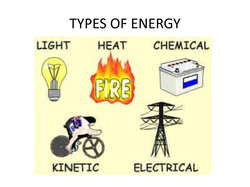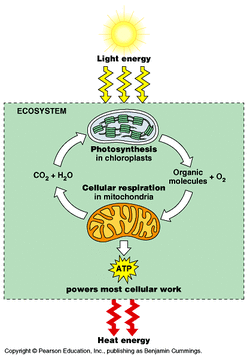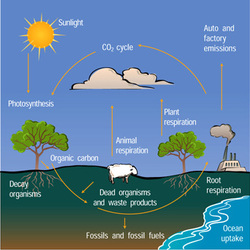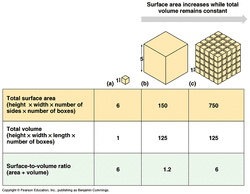- Home
- THE BIG PICTURE OF BIOLOGY
- BIG IDEA 1: EVOLUTION
- 1A: Evolution - Change in Genetic Makeup
- 1B: Evolution by Common Descent
- 1C: Life Continues to Evolve
- 1D: Theories of the History of Life
- BIG IDEA 2: ORGANISMS USE ENERGY AND MOLECULES TO GROW, REPRODUCE, AND MAINTAIN HOMEOSTASIS
- 2A: PHOTOSYNTHESIS, CELLULAR RESPIRATION, AND ENERGY
- 2B: CELL HOMEOSTASIS - CELL MEMBRANE PROCESSES
- 2.C: HOMEOSTASIS - POSITIVE AND NEGATIVE FEEDBACK
- 2.D: Growth and dynamic homeostasis of a biological system are influenced by changes in the system’s environment.
- 2.E: Many biological processes involved in growth, reproduction and dynamic homeostasis include temporal regulation and coordination.
- BIG IDEA 3: LIVING SYSTEMS STORE, RETRIEVE, TRANSMIT, AND RESPOND TO INFORMATION
- 3.A: DNA TRANSCRIPTION AND TRANSLATION
- 3.B: GENE REGULATION - TRANSCRIPTION AND TRANSLATION
- 3C: GENETIC MUTATIONS AND VIRUSES
- 3D: CELL COMMUNICATION AND SIGNAL TRANSDUCTION
- 3E: ANIMAL BEHAVIOR AND NERVOUS SYSTEM
- BIG IDEA 4: BIOLOGICAL SYSTEMS INTERACT IN COMPLEX WAYS
- 4A: BIOCHEMISTRY AND CELL BIOLOGY
- 4.B: Competition and cooperation are important aspects of biological systems.
- 4.C: Naturally occurring diversity among and between components within biological systems affects interactions with the environment.
- RESULTS AND RESOURCES
- AP BIO LABS: BIG IDEA 1 - EVOLUTION
- AP BIO LABS: BIG IDEA 2 -
- AP BIO LABS: BIG IDEA 3
- AP BIO LABS: BIG IDEA 4
Enduring understanding 2.A: Growth, reproduction and maintenance of the organization of living systems require free energy and matter.
Essential knowledge 2.A.1: All living systems require constant input of free energy.

a. Life requires a highly ordered system.
Evidence of student learning is a demonstrated understanding of each of the following:
1. Order is maintained by constant free energy input into the system.
2. Loss of order or free energy flow results in death.
3. Increased disorder and entropy are offset by biological processes that maintain or increase order.
b. Living systems do not violate the second law of thermodynamics, which states that entropy increases over time.
Evidence of student learning is a demonstrated understanding of each of the following:
1. Order is maintained by coupling cellular processes that increase entropy (and so have negative changes in free energy) with those that decrease entropy (and so have positive changes in free energy).
2. Energy input must exceed free energy lost to entropy to maintain order and power cellular processes.
3. Energetically favorable exergonic reactions, such as ATP→ADP, that have a negative change in free energy can be used to maintain or increase order in a system by being coupled with reactions that have a positive free energy change.
c. Energy-related pathways in biological systems are sequential and may be entered at multiple points in the pathway. [See also 2.A.2]
To foster student understanding of this concept, instructors can choose an illustrative example such as:
• Krebs cycle
• Glycolysis
• Calvin cycle
• Fermentation
d. Organisms use free energy to maintain organization, grow and reproduce.
Evidence of student learning is a demonstrated understanding of each of the following:
1. Organisms use various strategies to regulate body temperature and metabolism.
To foster student understanding of this concept, instructors can choose an illustrative example such as:
• Endothermy (the use of thermal energy generated by metabolism to maintain homeostatic body temperatures)
• Ectothermy (the use of external thermal energy to help regulate and maintain body temperature)
• Elevated floral temperatures in some plant species
2. Reproduction and rearing of offspring require free energy beyond that used for maintenance and growth. Different organisms use various reproductive strategies in response to energy availability.
To foster student understanding of this concept, instructors can choose an illustrative example such as:
• Seasonal reproduction in animals and plants
• Life-history strategy (biennial plants, reproductive diapause)
3. There is a relationship between metabolic rate per unit body mass and the size of multicellular organisms — generally, the smaller the organism, the higher the metabolic rate.
4. Excess acquired free energy versus required free energy expenditure results in energy storage or growth.
5. Insufficient acquired free energy versus required free energy expenditure results in loss of mass and, ultimately, the death of an organism.
e. Changes in free energy availability can result in changes in population size.
f. Changes in free energy availability can result in disruptions to an ecosystem.
To foster student understanding of this concept, instructors can choose an illustrative example such as:
Evidence of student learning is a demonstrated understanding of each of the following:
1. Order is maintained by constant free energy input into the system.
2. Loss of order or free energy flow results in death.
3. Increased disorder and entropy are offset by biological processes that maintain or increase order.
b. Living systems do not violate the second law of thermodynamics, which states that entropy increases over time.
Evidence of student learning is a demonstrated understanding of each of the following:
1. Order is maintained by coupling cellular processes that increase entropy (and so have negative changes in free energy) with those that decrease entropy (and so have positive changes in free energy).
2. Energy input must exceed free energy lost to entropy to maintain order and power cellular processes.
3. Energetically favorable exergonic reactions, such as ATP→ADP, that have a negative change in free energy can be used to maintain or increase order in a system by being coupled with reactions that have a positive free energy change.
c. Energy-related pathways in biological systems are sequential and may be entered at multiple points in the pathway. [See also 2.A.2]
To foster student understanding of this concept, instructors can choose an illustrative example such as:
• Krebs cycle
• Glycolysis
• Calvin cycle
• Fermentation
d. Organisms use free energy to maintain organization, grow and reproduce.
Evidence of student learning is a demonstrated understanding of each of the following:
1. Organisms use various strategies to regulate body temperature and metabolism.
To foster student understanding of this concept, instructors can choose an illustrative example such as:
• Endothermy (the use of thermal energy generated by metabolism to maintain homeostatic body temperatures)
• Ectothermy (the use of external thermal energy to help regulate and maintain body temperature)
• Elevated floral temperatures in some plant species
2. Reproduction and rearing of offspring require free energy beyond that used for maintenance and growth. Different organisms use various reproductive strategies in response to energy availability.
To foster student understanding of this concept, instructors can choose an illustrative example such as:
• Seasonal reproduction in animals and plants
• Life-history strategy (biennial plants, reproductive diapause)
3. There is a relationship between metabolic rate per unit body mass and the size of multicellular organisms — generally, the smaller the organism, the higher the metabolic rate.
4. Excess acquired free energy versus required free energy expenditure results in energy storage or growth.
5. Insufficient acquired free energy versus required free energy expenditure results in loss of mass and, ultimately, the death of an organism.
e. Changes in free energy availability can result in changes in population size.
f. Changes in free energy availability can result in disruptions to an ecosystem.
To foster student understanding of this concept, instructors can choose an illustrative example such as:
- Change in the producer level can affect the number and size of other trophic levels.
- Change in energy resources levels such as sunlight can affect the number and size of the trophic levels.
Essential knowledge 2.A.2: Organisms capture and store free energy for use in biological processes.

a. Autotrophs capture free energy from physical sources in the environment.
Evidence of student learning is a demonstrated understanding of each of the following:
1. Photosynthetic organisms capture free energy present in sunlight.
2. Chemosynthetic organisms capture free energy from small inorganic molecules present in their environment, and this process can occur in the absence of oxygen.
b. Heterotrophs capture free energy present in carbon compounds produced by other organisms.
Evidence of student learning is a demonstrated understanding of each of the following:
1. Heterotrophs may metabolize carbohydrates, lipids and proteins by hydrolysis as sources of free energy.
2. Fermentation produces organic molecules, including alcohol and lactic acid, and it occurs in the absence of oxygen.
3. Different energy-capturing processes use different types of electron acceptors.
such as:
d. The light-dependent reactions of photosynthesis in eukaryotes involve a series of coordinated reaction pathways that capture free energy present in light to yield ATP and NADPH, which power the production of organic molecules.
Evidence of student learning is a demonstrated understanding of each of the following:
1. During photosynthesis, chlorophylls absorb free energy from light, boosting electrons to a higher energy level in Photosystems I and II.
2. Photosystems I and II are embedded in the internal membranes of chloroplasts (thylakoids) and are connected by the transfer of higher free energy electrons through an electron transport chain (ETC). [See also 4.A.2]
3. When electrons are transferred between molecules in a sequence of reactions as they pass through the ETC, an electrochemical gradient of hydrogen ions (protons) across the thykaloid membrane is established.
4. The formation of the proton gradient is a separate process, but it is linked to the synthesis of ATP from ADP and inorganic phosphate via ATP synthase.
5. The energy captured in the light reactions as ATP and NADPH powers the production of carbohydrates from carbon dioxide in the Calvin cycle, which occurs in the stroma of the chloroplast.
e. Photosynthesis first evolved in prokaryotic organisms; scientific evidence supports that prokaryotic (bacterial) photosynthesis was responsible for the production of an oxygenated atmosphere; prokaryotic photosynthetic pathways were the foundation of eukaryotic photosynthesis.
f. Cellular respiration in eukaryotes involves a series of coordinated
enzyme-catalyzed reactions that harvest free energy from simple carbohydrates.
Evidence of student learning is a demonstrated understanding of each of the following:
1. Glycolysis rearranges the bonds in glucose molecules, releasing free energy to form ATP from ADP and inorganic phosphate, and resulting in the production of pyruvate.
2. Pyruvate is transported from the cytoplasm to the mitochondrion, where further oxidation occurs. [See also 4.A.2]
3. In the Krebs cycle, carbon dioxide is released from organic intermediates ATP is synthesized from ADP and inorganic phosphate via substrate level phosphorylation and electrons are captured by coenzymes.
4. Electrons that are extracted in the series of Krebs cycle reactions are carried by NADH and FADH2 to the electron transport chain.
g. The electron transport chain captures free energy from electrons in a series of coupled reactions that establish an electrochemical gradient across membranes.
Evidence of student learning is a demonstrated understanding of each of the following:
1. Electron transport chain reactions occur in chloroplasts (photosynthesis), mitochondria (cellular respiration) and prokaryotic plasma membranes.
2. In cellular respiration, electrons delivered by NADH and FADH2 are passed to a series of electron acceptors as they move toward the terminal electron acceptor, oxygen. In photosynthesis, the terminal electron acceptor is NADP+.
3. The passage of electrons is accompanied by the formation of a proton gradient across the inner mitochondrial membrane or the thylakoid membrane of chloroplasts, with the membrane(s) separating a region of high proton concentration from a region of low proton concentration. In prokaryotes, the passage of electrons is accompanied by the outward movement of protons across the plasma membrane.
4. The flow of protons back through membrane-bound ATP synthase by chemiosmosis generates ATP from ADP and inorganic phosphate.
5. In cellular respiration, decoupling oxidative phosphorylation from electron transport is involved in thermoregulation.
h. Free energy becomes available for metabolism by the conversion of ATP→ADP, which is coupled to many steps in metabolic pathways.
1. Photosynthetic organisms capture free energy present in sunlight.
2. Chemosynthetic organisms capture free energy from small inorganic molecules present in their environment, and this process can occur in the absence of oxygen.
b. Heterotrophs capture free energy present in carbon compounds produced by other organisms.
Evidence of student learning is a demonstrated understanding of each of the following:
1. Heterotrophs may metabolize carbohydrates, lipids and proteins by hydrolysis as sources of free energy.
2. Fermentation produces organic molecules, including alcohol and lactic acid, and it occurs in the absence of oxygen.
3. Different energy-capturing processes use different types of electron acceptors.
such as:
- NADP+ in photosynthesis
- Oxygen in cellular respiration
d. The light-dependent reactions of photosynthesis in eukaryotes involve a series of coordinated reaction pathways that capture free energy present in light to yield ATP and NADPH, which power the production of organic molecules.
Evidence of student learning is a demonstrated understanding of each of the following:
1. During photosynthesis, chlorophylls absorb free energy from light, boosting electrons to a higher energy level in Photosystems I and II.
2. Photosystems I and II are embedded in the internal membranes of chloroplasts (thylakoids) and are connected by the transfer of higher free energy electrons through an electron transport chain (ETC). [See also 4.A.2]
3. When electrons are transferred between molecules in a sequence of reactions as they pass through the ETC, an electrochemical gradient of hydrogen ions (protons) across the thykaloid membrane is established.
4. The formation of the proton gradient is a separate process, but it is linked to the synthesis of ATP from ADP and inorganic phosphate via ATP synthase.
5. The energy captured in the light reactions as ATP and NADPH powers the production of carbohydrates from carbon dioxide in the Calvin cycle, which occurs in the stroma of the chloroplast.
e. Photosynthesis first evolved in prokaryotic organisms; scientific evidence supports that prokaryotic (bacterial) photosynthesis was responsible for the production of an oxygenated atmosphere; prokaryotic photosynthetic pathways were the foundation of eukaryotic photosynthesis.
f. Cellular respiration in eukaryotes involves a series of coordinated
enzyme-catalyzed reactions that harvest free energy from simple carbohydrates.
Evidence of student learning is a demonstrated understanding of each of the following:
1. Glycolysis rearranges the bonds in glucose molecules, releasing free energy to form ATP from ADP and inorganic phosphate, and resulting in the production of pyruvate.
2. Pyruvate is transported from the cytoplasm to the mitochondrion, where further oxidation occurs. [See also 4.A.2]
3. In the Krebs cycle, carbon dioxide is released from organic intermediates ATP is synthesized from ADP and inorganic phosphate via substrate level phosphorylation and electrons are captured by coenzymes.
4. Electrons that are extracted in the series of Krebs cycle reactions are carried by NADH and FADH2 to the electron transport chain.
g. The electron transport chain captures free energy from electrons in a series of coupled reactions that establish an electrochemical gradient across membranes.
Evidence of student learning is a demonstrated understanding of each of the following:
1. Electron transport chain reactions occur in chloroplasts (photosynthesis), mitochondria (cellular respiration) and prokaryotic plasma membranes.
2. In cellular respiration, electrons delivered by NADH and FADH2 are passed to a series of electron acceptors as they move toward the terminal electron acceptor, oxygen. In photosynthesis, the terminal electron acceptor is NADP+.
3. The passage of electrons is accompanied by the formation of a proton gradient across the inner mitochondrial membrane or the thylakoid membrane of chloroplasts, with the membrane(s) separating a region of high proton concentration from a region of low proton concentration. In prokaryotes, the passage of electrons is accompanied by the outward movement of protons across the plasma membrane.
4. The flow of protons back through membrane-bound ATP synthase by chemiosmosis generates ATP from ADP and inorganic phosphate.
5. In cellular respiration, decoupling oxidative phosphorylation from electron transport is involved in thermoregulation.
h. Free energy becomes available for metabolism by the conversion of ATP→ADP, which is coupled to many steps in metabolic pathways.
Essential knowledge 2.A.3: Organisms must exchange matter with the environment to grow, reproduce and maintain organization.

a. Molecules and atoms from the environment are necessary to build new molecules.
Evidence of student learning is a demonstrated understanding of each of the following:
1. Carbon moves from the environment to organisms where it is used to build carbohydrates, proteins, lipids or nucleic acids. Carbon is used in storage compounds and cell formation in all organisms.
2. Nitrogen moves from the environment to organisms where it is used in building proteins and nucleic acids. Phosphorus moves from the environment to organisms where it is used in nucleic acids and certain lipids.
3. Living systems depend on properties of water that result from its polarity and hydrogen bonding.
To foster student understanding of this concept, instructors can choose an illustrative example such as:
• Cohesion
• Adhesion
• High specific heat capacity
• Universal solvent supports reactions
• Heat of vaporization
• Heat of fusion
• Water’s thermal conductivity
Evidence of student learning is a demonstrated understanding of each of the following:
1. Carbon moves from the environment to organisms where it is used to build carbohydrates, proteins, lipids or nucleic acids. Carbon is used in storage compounds and cell formation in all organisms.
2. Nitrogen moves from the environment to organisms where it is used in building proteins and nucleic acids. Phosphorus moves from the environment to organisms where it is used in nucleic acids and certain lipids.
3. Living systems depend on properties of water that result from its polarity and hydrogen bonding.
To foster student understanding of this concept, instructors can choose an illustrative example such as:
• Cohesion
• Adhesion
• High specific heat capacity
• Universal solvent supports reactions
• Heat of vaporization
• Heat of fusion
• Water’s thermal conductivity

b. Surface area-to-volume ratios affect a biological system’s ability to obtain necessary resources or eliminate waste products.
Evidence of student learning is a demonstrated understanding of each of the following:
1. As cells increase in volume, the relative surface area decreases and demand for material resources increases; more cellular structures are necessary to adequately exchange materials and energy with the environment. These limitations restrict cell size.
To foster student understanding of this concept, instructors can choose an illustrative example such as:
• Root hairs
• Cells of the alveoli
• Cells of the villi
• Microvilli
2. The surface area of the plasma membrane must be large enough to adequately exchange materials; smaller cells have a more favorable surface area-to-volume ratio for exchange of materials with the environment.
Evidence of student learning is a demonstrated understanding of each of the following:
1. As cells increase in volume, the relative surface area decreases and demand for material resources increases; more cellular structures are necessary to adequately exchange materials and energy with the environment. These limitations restrict cell size.
To foster student understanding of this concept, instructors can choose an illustrative example such as:
• Root hairs
• Cells of the alveoli
• Cells of the villi
• Microvilli
2. The surface area of the plasma membrane must be large enough to adequately exchange materials; smaller cells have a more favorable surface area-to-volume ratio for exchange of materials with the environment.
